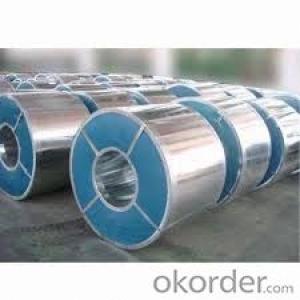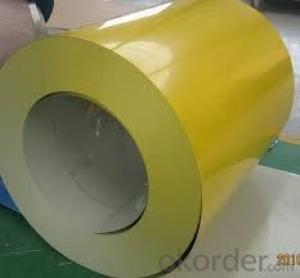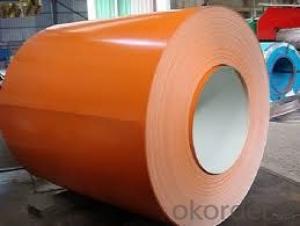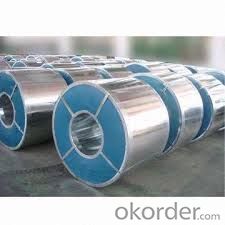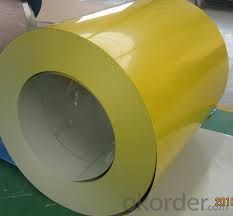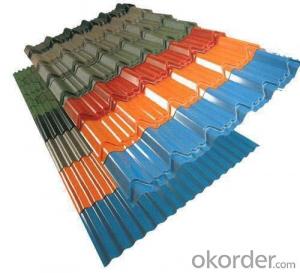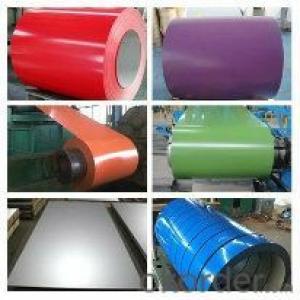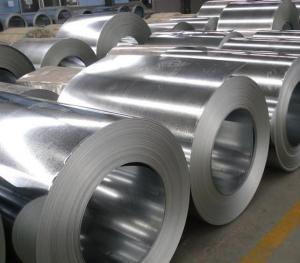Printed Color Galvanized Steel Coil/Color Steel Rolled
- Loading Port:
- Shanghai
- Payment Terms:
- TT OR LC
- Min Order Qty:
- 20 m.t.
- Supply Capability:
- 18000 m.t./month
OKorder Service Pledge
OKorder Financial Service
You Might Also Like
Product Description
Military Printed Color Galvanized Steel Coil
1. Techinical standard: EN10169
2. Grade: TDX51D, TSGCC
3. Color: Ral standard or according to customers' requirment
4. Thickness: 0.14-0.8mm (the most advantage thickness)
5. Width: 600-1250mm (610/724/820/914/1000/1200/1219/1220/1250)
6. Base metal: Galvanized / galvalume steel / cold rolled
7. Finish Painting: 15-20miu PE on top
Back painting: 5-8miu EP on back
8. Type of PPGI: PPGI with military pattern
Product category and properties: The products can be divided into the following sorts in the light of their specific manufacturing and processing methods:
1. Hot-dip galvanized steel coil. Its the most common galvanized steel product at present.
2. Hot-dip galvalume steel coil. Al-Zn galvanized steel sheet. General use, construction industry, household appliance industry, automobile industry and industrial instruments.
3. Color coating steel coil. Any color according to the requests of customers. General use, for drawing, structure, construction industry (outdoor), factory building, agricultural warehouse, prefabricated ports of residence, title roof and furniture appliance.
4. Guardrail. Highway guardrail/fence can be used for both sides of highway and road. Available in any different sizes. Hot-dipped galvanized or galvalume steel sheet. Spraying plastics in your exact specifications.
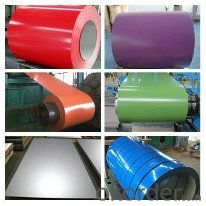
| Back painting: | 5-7 mic. EP |
| Color: | According to RAL standard |
| commodity | Color-coated Galvanized Steel Coil (PPGI/ PPGL) |
| Techinical Standard: | JIS G3302-1998, EN10142/10137, ASTM A653 |
| grade | TSGCC, TDX51D / TDX52D / TS250, 280GD |
| Types: | For general / drawing use |
| Thickness | 0.14-1.0mm(0.16-0.8mm is the most advantage thickness)) |
| Width | Width: 610/724/820/914/1000/1200/1219/1220/1250mm |
| Type of coating: | PE, SMP, PVDF |
| Zinc coating | Z60-150g/m2 or AZ40-100g/m2 |
| Top painting: | 5 mic. Primer + 15 mc. R. M. P. |
| ID coil | 508mm / 610mm |
| Coil weight: | 4--8MT |
| Package: | Properly packed for ocean freight exportation in 20' ' containers |
| Application: | Industrial panels, roofing and siding for painting / automobile |
| Price terms | FOB, CFR, CIF |
| Payment terms | 20%TT in advance+80% TT or irrevocable 80%L/C at sight |
| delivery time | 25 days after recepit of 20% TT |
| Remarks | Insurance is all risks |
| MTC 3.1 will be handed on with shipping documents | |
| We accept SGS certificatation test |
Q&A What is the validity of your quotation?
ANSWER: Normally 2 days
- Q: How are steel coils used in the manufacturing of mining equipment?
- Steel coils are used in the manufacturing of mining equipment for various purposes, such as forming the structural components, building frames, and creating durable and robust machinery. These coils are often shaped, cut, and welded to construct mining machinery that can withstand the harsh conditions and heavy-duty operations in the mining industry.
- Q: I work in a steel foundry 10-12 hours a day where we melt and pour stainless steel tubes. The pour temperature for some of them is very close to the boiling point of stainless steel (about 3800 degrees) because it has to be VERY liquid for the application we use it. Anyway, it does boil a little and we breath in the vapours which I can assure you ARE indeed vapourized stainless steel (it collects and cools on everything and makes a nice shiny coating). Ok, so to the question, does breathing vapourized stainless steel all day pose a health risk such as cancer? Anyone know? I'm just curious.
- I would imagine it's not good. I doubt cancer but I suppose it may be possible. Shouldn't you guys have respirator gear on? Where's OSHA when you need'em? ;)
- Q: Will a stainless steel mesh screen scratch a titanium cup, or vice versa?I have a titanium french press and am thinking about replacing the included press with an all steel one. I am worried about little flakes of titanium or steel getting ground off into the coffee when the press slides in and out. The original press has a polyester cloth for a screen, so nothing scratches.
- Steel is usually harder than titanium, at least when both materials are hear-treated to give their best strengths. And a harder material can scratch a softer one. So I imagine that the answer is that it will scratch. However much of the rest of your question is unclear and it may be that the amount of friction between the two is so small that no wear will take place, so there could be no problem. The function of the polyester cloth may be vital in reducing this friction, so that unless you keep this part of the original design, the scratching will become worse no matter which combination of metals are used.
- Q: How are steel coils annealed to improve their properties?
- Steel coils are annealed by heating them to a specific temperature and then slowly cooling them down. This process helps to relieve internal stresses, improve ductility, and refine the grain structure, resulting in enhanced mechanical properties.
- Q: I am planning to buy a Walther P22. I have liked the Pistol's performance-superb.The only confusion that I have is about the Polymer Frame.Just for this I may shift to someother manufacturer.Are Polymer Frames better than Steel in durability and lifespan.Walther says YES.Any comments on this...Practical users...Thanks in advance
- All polymer frames are cast around steel 'skeleton' inserts, which bear the stress and wear between receiver slide, as well as other wear points. The great advantage to polymer frames is the lower weight over the polymer composite compared to an all-steel or other metal alloy receiver frame. As all wear contact points are 'steel-to-steel', the service life expectancy of a polymer-frame weapon will be the same as an all-steel frame design. NO polymer-frame design I know of has ANY stress or load contact points between metal and polymer-only surfaces. My polymer-frame H-K USP and my Glocks are constructed this way.
- Q: How are steel coils used in the manufacturing of marine equipment?
- Steel coils are commonly used in the manufacturing of marine equipment as they provide a strong and durable material for various applications. These coils are often shaped, cut, and formed into different components such as hulls, propeller shafts, and structural supports. The high tensile strength of steel coils ensures the equipment's ability to withstand the harsh conditions of marine environments, including corrosion and pressure from waves and currents. Additionally, steel coils can be easily welded, making them suitable for constructing larger structures like ship decks and bulkheads.
- Q: I'm analysing horse stirrups and would like to know the disadvantages to stainless steel? - thanks
- For horse stirrups the main disadvantage to stainless steel is the manufacturing cost. Stainless steels tend to work harden, and are subject to their own peculiar forms of corrosion, but I see little implication to either of these factors when used as a stirrup iron or a safety latch. Stainless steel is also subject to self welding, or galling, this would be of no concern for the irons, but could result in the pivot of the safety latch freezing (I have never known anyone to ride with the safety latch closed, however).
- Q: I need details for steel column splices welded or bolted. References or autocad blocks will be very useful. Thank you very much!
- The refernce for Canada is S16-01 Limit states steel design My professor always taugth us shop weld field bolt if that helps
- Q: No. Not Stainless steel, I mean STEEL.Not a specific type, but STEEL.Thanks. xo
- Scott, there are 3 types of materials: elements, compounds, and mixtures. Compounds are covalently bonded elements. Compounds and elements are both considered 'pure' substances. Mixtures are not bonded in any fashion. So a steel mixture can have varying amounts of iron, carbon, silica,molybdenum, etc., giving the steel the desired properties (strength, rigidity, rust resistance, etc.).
- Q: What are the different methods of edge trimming for steel coils?
- There are several different methods of edge trimming for steel coils, including slitting, shearing, and laser cutting. Slitting involves cutting the coil into narrower strips using circular blades. Shearing involves cutting the edges of the coil using a straight blade. Laser cutting uses a high-powered laser to precisely trim the edges of the coil.
Send your message to us
Printed Color Galvanized Steel Coil/Color Steel Rolled
- Loading Port:
- Shanghai
- Payment Terms:
- TT OR LC
- Min Order Qty:
- 20 m.t.
- Supply Capability:
- 18000 m.t./month
OKorder Service Pledge
OKorder Financial Service
Similar products
Hot products
Hot Searches
Related keywords
